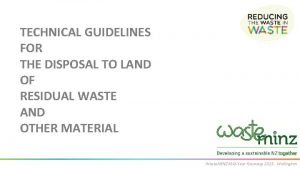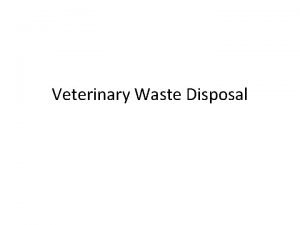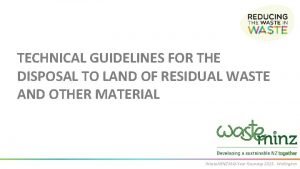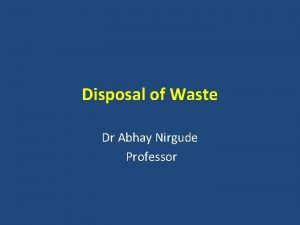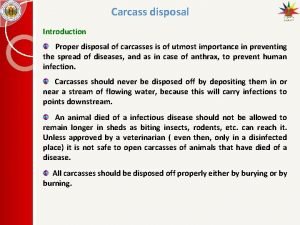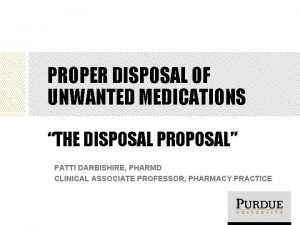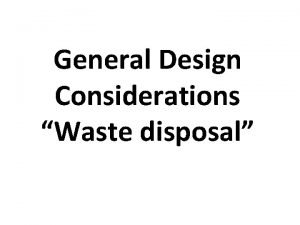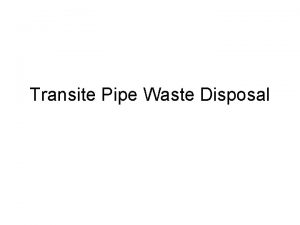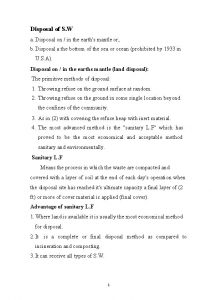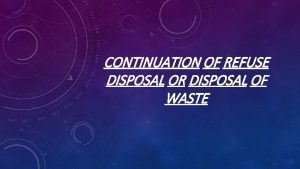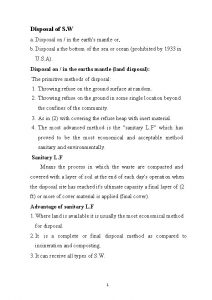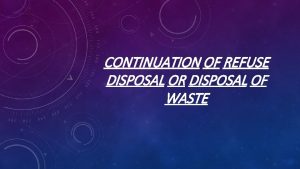TECHNICAL GUIDELINES FOR THE DISPOSAL TO LAND OF














- Slides: 14

TECHNICAL GUIDELINES FOR THE DISPOSAL TO LAND OF RESIDUAL WASTE AND OTHER MATERIAL your logo here Waste. MINZ Mid-Year Roundup 2013. Wellington

• Objectives • define waste types intended for disposal • define classes of landfill based on waste types • provide a consistent approach to landfill siting, design, operations and monitoring • make good practice recommendations on key technical requirements for siting, design, operations and monitoring of landfills based on landfill class. your logo here Waste. MINZ Mid-Year Roundup 2013. Wellington

• Land Disposal Technical Guidelines • Revise • CAE Landfill Guidelines (2000) • Guide to the Management of Cleanfills • Three major changes • Landfill classification • Good practice design • Waste acceptance criteria your logo here Waste. MINZ Mid-Year Roundup 2013. Wellington

• Disposal to land means the final deposit of fill and/or waste materials into or onto land set apart for that purpose (landfill) • Disposal to land does not include: • earthworks operations • farm dumps • offal holes your logo here Waste. MINZ Mid-Year Roundup 2013. Wellington

• Waste definitions • Cleanfill (revised) • Managed/Controlled fill (new) • Construction and Demolition (C&D) Waste (new) • Household Waste (new) • Industrial Waste • Municipal Solid Waste • Hazardous Waste your logo here Waste. MINZ Mid-Year Roundup 2013. Wellington

• Cleanfill • Material that when discharged to the environment will not have a detectable effect relative to the background and comprising virgin excavated natural materials (VENM) such as clay, soil and rock that are free of: (list of exclusions)… your logo here Waste. MINZ Mid-Year Roundup 2013. Wellington

• Managed/Controlled Fill • Fill material that is predominantly cleanfill, but may contain specified inert materials, such as concrete or brick and soils with concentrations of selected chemical contaminants that are greater than local background soil concentrations, but with specified maximum total concentrations your logo here Waste. MINZ Mid-Year Roundup 2013. Wellington

• Construction and Demolition Waste • Waste generated from the construction, renovation, repair, and demolition of structures such as residential and commercial buildings, roads, and bridges. The composition of C&D waste varies for these different activities and structures. Overall, C&D waste is composed mainly of wood products, asphalt, plasterboard, and masonry your logo here Waste. MINZ Mid-Year Roundup 2013. Wellington

• Landfill Classes • Class 4 (Cleanfill) • Class 3 (Managed/Controlled Fill) • Class 2 (C&D Landfill or Industrial Waste Landfill) (lined) • Class 1 (MSW Landfill or Industrial Waste Landfill - Class A) (lined) your logo here Waste. MINZ Mid-Year Roundup 2013. Wellington

• Guidelines reflect current situation where “cleanfills” range from site accepting only VENM to sites accepting quantities of C&D waste or contaminated soils • Recognize that different wastes require sites with different levels of environmental protection • Already have lined C&D sites your logo here Waste. MINZ Mid-Year Roundup 2013. Wellington

• Key Design Revisions • Clay liner and leachate collection for Class 2 landfills (C&D landfills and some industrial waste landfills) • Composite liner required for Class 1 landfills your logo here Waste. MINZ Mid-Year Roundup 2013. Wellington

Class Groundwater Separation 4 3 2 1 NA 1 2 2 NA NA Yes (m) Groundwater Underdrains Stormwater Diversion Yes Yes Stormwater Retention Site Specific Yes Minimum Base Grade NA NA 2% 2% Liner - Clay NA NA 900 mm @ < 1 x 10 -8 NA m/sec Liner - Composite NA NA HDPE 1. 5 mm, GCL, and HDPE 1. 5 mm, and 600 300 mm clay @ < 1 x 10 -9 8 m/s HDPE 1. 5 mm, GCL, and Key Design Requirements 600 mm clay @ < 1 x 108 m/s HDPE 1. 5 mm, GCL, and 300 mm clay @ < 1 x 109 m/s Piggy Back Liner HDPE 1. 5 mm, and 600 mm clay @ < 1 x 10 -8 m/s Leachate Collection System NA NA Slotted Pipes Components Maximum Leachate Head Drainage Media Layer and Slotted Pipes NA NA 500 mm your logo here 300 mm (mm) Waste. MINZ Mid-Year Roundup 2013. Wellington

• Waste Acceptance Criteria • Waste types suitable for each landfill class • Contaminant limits • Total inorganic and organic limits for Class 4 and Class 3 landfills • TCLP limits for Class 2 and Class 1 landfills • Want feedback on draft limits your logo here Waste. MINZ Mid-Year Roundup 2013. Wellington

Class Common Waste Description Incidental Materials Waste Acceptance Criteria Cleanfill Maximum incidental inert manufactured Based on maximum total materials (e. g. concrete, brick, tiles) to be concentration limits derived from no more than 5% by volume per load; the regional background, and Maximum incidental or attached limited organic compounds. Name 4 Cleanfill biodegradable materials (e. g. vegetation) to be no more than 2% by volume per load. 3 2 1 Managed/ Cleanfill Maximum incidental or attached Controlled/ biodebradable materials (e. g. vegetation) to concentration limits and limited Fill Managed Fill be no more than 2% by volume per load. organic compounds Construction Cleanfill Maximum incidental or attached Based on USEPA TCLP limits. and Controlled/ biodebradable materials (e. g. vegetation) to Demolition Managed Fill be no more than 5% by volume per load. Landfiill – C&D Waste Lined Inert Industrial Waste MSW Cleanfill Landfill Controlled/ Based on maximum total Waste Acceptance Criteria Based on USEPA TCLP limits. Managed Fill C&D Waste Municipal Solid Waste Household Waste Commercial Waste Industrial Waste Treated Hazardous your logo here Waste. MINZ Mid-Year Roundup 2013. Wellington
 Technical guidelines for disposal to land
Technical guidelines for disposal to land Bva waste disposal
Bva waste disposal Flood hazard area land use management guidelines
Flood hazard area land use management guidelines What are landforms
What are landforms Identifying landforms
Identifying landforms Bra mat för unga idrottare
Bra mat för unga idrottare Geometri för barn
Geometri för barn Bästa kameran för astrofoto
Bästa kameran för astrofoto En lathund för arbete med kontinuitetshantering
En lathund för arbete med kontinuitetshantering Ledarskapsteorier
Ledarskapsteorier Offentlig förvaltning
Offentlig förvaltning Datorkunskap för nybörjare
Datorkunskap för nybörjare Kvinnlig mantel i antikens rom
Kvinnlig mantel i antikens rom Vilken grundregel finns det för tronföljden i sverige?
Vilken grundregel finns det för tronföljden i sverige? Rita perspektiv
Rita perspektiv
